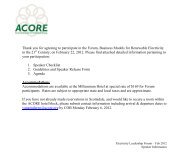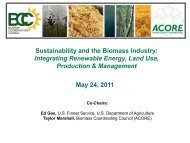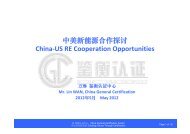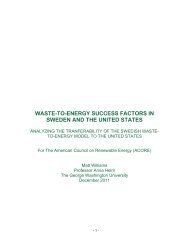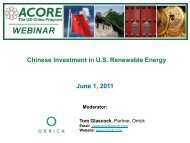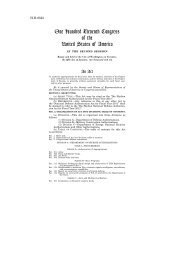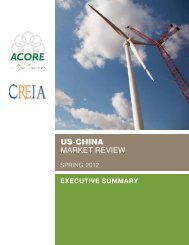Barriers for the wind industry include lack of transmissioninfrastructure, constrained supply of copper and steel,policy inconsistency, high cost, and additional regulatorybarriers. Turbine technology will continue to improve onlywith a supportive policy environment and incentives forresearch and development.Small wind turbine applications face challengesas well.Many of the same obstacles to large-scale wind apply tosmall wind, including cost issues and resource variability.Federal PolicyThe Production Tax Credit (PTC) has helpedgenerate a strong wind industry in the USThe primary federal policy that hassupported the wind energy industryhistorically is the Production Tax Credit (PTC), a$.021/kWh credit for wind energy. With thePTC, the federal government engages in apublic-private partnership with wind farmdevelopers, paying up to 2/3 of the capital costof new wind projects.The tax system is an effective vehicle toraise money for public use but also toincent behavior and growth.– Matt Ferguson, Principal, Reznick GroupChanges in federal policy will help winddevelopers and provide flexibility.Under the <strong>American</strong> Recovery and Reinvestment Act(ARRA), the PTC was extended through 2012, and developersmay receive an Investment Tax Credit (ITC) instead,which gives developers an up-front credit for investmentinstead of a credit after the project is completed.Cash grants make the federal incentives evenmore accessible.Another important change in the law is that developersmay elect to receive a cash grant in lieu of the ITC. Thesechanges in policy affect the market by lowering costs fordevelopers—making wind energy cost-competitive withcoal—and increasing consumer demand for wind energy.FinanceThe wind market has been heavily reliant on taxequity financing, but this model experienced adownturn in late 2008.Although the number of wind installationswas greater in 2008 than in any other year,asset transactions decreased steadily from thebeginning of 2008 through the end of the yearas a result of the capital market crash.With a supportive policy environment, marketswill rebound.The ARRA, or stimulus bill, is expected to boost markets.Also, the DOE’s loan guarantee program will be especiallypopular, and although markets will continue to slow in2009, the market will pick up again in 2010.Wind markets are still heavily reliant on federaltax credits.In coming years, the wind industry must find ways to beless reliant on tax credits, since these are set to expire atthe end of 2012.Wind Resource and EconomicsKnowing the strength and quality of a windresource can affect the economics of windprojects.Strong, consistent resources create the idealconditions for wind energy projects, becausethey allow turbines to generate the most energyper hour.Wind resource patterns are not consistent,creating wind integration costs related tovariability and uncertainty of the resource.It is important for developers to have accurate forecasts ofwind resource patterns, since wind speeds can typicallychange from year to year. Power system operators wantreliability above all else. Demand management, storage,and plug-in hybrid vehicles can help reduce uncertaintyand help with wind integration.<strong>American</strong> <strong>Council</strong> <strong>On</strong> <strong>Renewable</strong> <strong>Energy</strong>Executive Summary Report 64
Regional FactorsBesides federal policy, state and local policiesaffect wind energy deployment.State renewable portfolio standards, taxincentives, and other state policies andregulations have a significant effect on windenergy installations on a state by state basis.There are no fundamental barriers toachieving 20-30% electricity from wind.– James Lyons, Chief Technology Officer, Novus<strong>Energy</strong> PartnersOther regional factors affect wind energycapacity installed as well.These factors include the local wind resource, wholesalepower prices, access to a merchant market, access totransmission, siting issues, and eligibility to meet RPSdemand.ConclusionsSpeakers in the RETECH wind energy sessionsoffered a sober but optimistic view of the USwind market for 2009. Though they expect windenergy installations to be modest in 2009, themarket is expected to rebound in 2010. Additionally,as wind turbine engineering improvementsdrive down the cost of turbine components,demand for wind energy will increase. Aslong as the barriers to large-scale wind deploymentare removed—including an expansion ofthe transmission grid and the enactment ofsupportive policies—the market for wind energyin America will continue to grow, helping toensure a clean energy future for the country.Session ReferencesB3 - Wind TechnologyRobert Thresher, Research Fellow, National <strong>Renewable</strong> <strong>Energy</strong> Lab (NREL) (Chair) [slides]Steven Saylors, Chief Electrical Engineer, Vestas-<strong>American</strong> Wind Technology, Inc. [slides]Mike Hess, CEO, Mariah Power [slides]James P. Lyons, Chief Technology Officer, Novus <strong>Energy</strong> Partners [slides]Dan Juhl, CEO and Chairman, Juhl Wind, Inc. [slides]B4 - Wind Economics, Finance & PolicyMatt Ferguson, Lead/Principal of National <strong>Renewable</strong> <strong>Energy</strong> Practice, Reznick Group (Chair) [slides]Richard Krauze, Director of North <strong>American</strong> Business Development, 3TIER [slides]John Eber, Managing Director-<strong>Energy</strong> Investments, JP MorganEd Feo, Partner, Milbank [slides]B5 - Wind Markets & ProjectsRichard Krauze, Director of Business Development for North America, 3TIER (Chair)David Hastings, Vice President Development, Western Region, Acciona <strong>Energy</strong> North <strong>American</strong> Corp. [slides]Barrett Stambler, Vice President, <strong>Renewable</strong> Origination, Iberdrola <strong>Renewable</strong>s, Inc. [slides]Mark Ahlstrom, CEO, WindLogics [slides]Anntonette Alberti, Vice President, Tetra Tech [slides]<strong>American</strong> <strong>Council</strong> <strong>On</strong> <strong>Renewable</strong> <strong>Energy</strong>Executive Summary Report 65
- Page 6:
The highlights of WIREC 2008 includ
- Page 9 and 10:
EVENT SPONSORSHosted byBadge Sponso
- Page 11 and 12:
EXHIBITORS ContinuedKamatics Corp.K
- Page 13 and 14:
The ARRA contains the following ite
- Page 15 and 16:
“How do we organize ourselves to
- Page 17 and 18:
John GeesmanFormer Commissioner, Ca
- Page 19 and 20:
Cathy ZoiCEO, Alliance for Climate
- Page 21 and 22:
John CavalierManaging Partner, Huds
- Page 23 and 24:
BiofuelsChristopher Groobey, Partne
- Page 25 and 26: Patrick Cloney, Executive Director,
- Page 27 and 28: Gal Luft, Executive Director, Insti
- Page 29 and 30: Daniel Kammen, Class of 1935 Distin
- Page 31 and 32: Biomass, Biofuels, and Advanced Veh
- Page 33 and 34: Critical development opportunities
- Page 35 and 36: ConclusionsSpeakers at RETECH 2009
- Page 37 and 38: Geothermal PowerOverviewThe United
- Page 39 and 40: Green Buildings and CommunitiesOver
- Page 41 and 42: Green construction and renovation s
- Page 43 and 44: Session ReferencesGreen Schools Bre
- Page 45 and 46: 1. The local electric power market
- Page 47 and 48: International Renewable Energy Indu
- Page 49 and 50: production was 37%; the domestic tu
- Page 51 and 52: There have been a number of incenti
- Page 53 and 54: educes mortality and improves gende
- Page 55 and 56: D7 - ChinaJing Su, Director of US-C
- Page 57 and 58: past, uncertain legislative environ
- Page 59 and 60: marketplace, accelerating and deepe
- Page 61 and 62: • Complexity and operating costs
- Page 63 and 64: C6 - Environmental and Carbon Finan
- Page 65 and 66: The technology debate: thin film ve
- Page 67 and 68: FITs have grown in popularity over
- Page 69 and 70: Haroula Reitz, Global Manager of Sc
- Page 71 and 72: Currently, planning is geographical
- Page 73 and 74: Federal policy should allow for a c
- Page 75: Wind: Markets, Technologies, and Po






